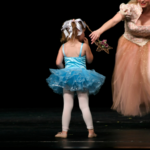Behind all of those lovely sequins there typically lies hard work, hassles and headaches for studio owners.
How can you avoid that? Or at least minimize the pain of it all?
DanceTeacher Magazine has published articles in the past that offer tried and true methods for making costume ordering easier. We’ve pulled together the most critical components into a set of Best Practices for Painless Costuming.
First of all, it helps reduce your frustration if you just accept that there are two things that you can’t eliminate or control – no matter how much you plan or research:
- Whether students like or dislike their costumes
- That each student is not going to get the perfect fit
There are, however, plenty of areas that you can exert control over and therefore reduce the chaos that typically abounds during the costume ordering process.
Best Practices for Painless Costuming
- Start Your Process Early
Today’s manufacturer demands have forced order deadlines to be earlier and earlier each year. There is no “too early” when it comes to the best time to start the process. Logistics have become so tight for some manufacturers that a difference in a couple of days on the ordering end can delay delivery by several weeks.
Many studio owners order Spring costumes during the preceding December. Some are starting even earlier, having orders into costume manufacturers before December arrives.
Ordering prior to December of the preceding year gives studio owners:
- Delivery of costumes more quickly
- Better chance to have a smooth resolution process for mistakes and issues
- Incentives or discounts from manufacturers
- Confidence that all costuming details are completed ahead of key dates
Set early ordering deadlines for yourself and stick to them to make everything easier when dates for picture days and recitals are looming.
- Account for Growth
Regardless of how carefully you measure, in growing child will not fit the December measurement in April. Learn how to compensate for growth. Experienced studio owners have a “norm” for the inches they add for growth: 2 to the hip, waist and bust measurements and 4 to the girth. Some manufacturers have their own guides for such estimations and it helps to display these in studio. This also gives you the opportunity to hand the measurement responsibilities over to parents who should be able to follow the manufacturers’ guidelines.
- Maintain Simplicity
The best way to keep it simple is to limit the number of people involved in the decision. Whether you decide to make all decisions yourself or enlist help from a limited crew, keep the number of participants to a bare minimum. Another way to cut down the confusion is to keep costume catalogues out of parents’ hands. Studio owners have seen nightmares develop when parents go around them to manufacturers to try to get “the best prices” for their children’s costumes. A strict staff-only policy when it comes to costume ordering must be in place and followed to the letter.
- Don’t Discount Your Hard Work
Don’t short yourself for all of the time it takes to accomplish all that it takes to get those beautiful costumes on your dancers.
Research, Comparison, Ordering
It takes almost endless hours to measure, research catalogs, process orders, sort through boxes and trouble-shoot fitting and quality issues. You travel to conventions, feel fabrics, gauge quality and compare pricing to put together each class’ performance package. You may even include recital DVDs and CDs of practice and class pictures.
Pricing
And then there are pricing decisions. A variety of approaches are represented across dance studios:
- Standardizing a price across the school that all teachers must stick to
- Creating a sliding scale based on size
- Creating packages that are different each year but are offered at the same price point for all students
To determine what “formula” you should adopt, take stock of your customers’ needs and your studios situation.
- Reward Reliable Manufacturers
What good is a great selection of costumes if you don’t know that you will receive the costume you want on time? By giving repeat business to those who follow through with good customer services, you are encouraging that manufacturer to continue their best practices.
When you find that good manufacturer, build a relationship. Because trust has been earned on both sides, you can ask for help in accomplishing your costuming goals. Many costume manufacturers are small companies and owners and designers are pretty accessible and prefer developing relationships with their loyal customers.
- Take Care of Your Costumes
We’re including costume care as a point of Best Practice because the proper care and storage of costumes can help you reuse existing costumes and cut down on the number of new ones that you must order.
Cleaning
Read care labels. Not all costumes are treated in the same way. Some sequins, crystals or other embellishments require special treatment or will be ruined. If you have doubts, call the manufacturer. Regardless of how you determine it, use the process that is best for the fabric and embellishments of the costume.
Dry clean as little as possible. The chemicals are tough on the fabrics and its expensive. Spot clean items where they touch dancers’ bodies (i.e., spray armpit areas with an alcohol-water mixture) Soaps and sprays available to clean and fresh delicate fabrics such as Fresh Again Uniform & Costume Deodorant Spray and Fels-Naptha laundry soap for removing make-up stains. Safe dry clean fabrics usually include velvet, chiffon, georgette and constructed items like military jackets. Use a dry cleaner that understands how to handle delicates and the extra care that dance costumes require.
Machine-washing can be done with some fabrics: synthetics, sturdy cottons and permanent-press fabrics. Use large lingerie bags to add protection in machines.
Hand cleaning and washing can be done with lycra, spandex, tulle, wool, silk and anything with sequins and delicate embellishments. Silk can be washed in cold water mixed with a little vinegar. Other fabrics noted here can be washed (for no more than two minutes) in cold water with hand-washing detergent.
What about tutus? Hand wash just the panty part. Any other necessary areas can be spot cleaned with Dr. Bronner’s peppermint liquid soap.
Some stains can be prevented by encouraging the use of clear deodorant and eliminating the use of perfumes.
Leotards and tights can and should be washed after every wearing. Costumes can be spot-cleaned and treated with Fresh Again between performances in a series, but wait until after the end of the run to hand-wash. machine wash or dry-clean costumes.
Drying
Again – read care labels! Cotton and polyester can be tumbled dry using a gentle setting in a loose (never over-loaded) dryer. Delicate fabrics can be roll-dried by placement on a color-fast towel and rolling down the length of the towel to gently squeeze out the liquid. Lay the costume on a fresh towel to dry. Dry tutus upside down on a hanger after spot cleaning.
Removing Wrinkles
Pressing items? Read the label and then, if pressing is allowing, place a towel between the costume and the iron and press with the iron on low heat. A steamer is a good investment for a studio so that wrinkles can be more easily removed and the costume freshened. Always steam carefully from the underside. Steaming comes in really handy after storage.
Storing
The goal is setting up costume storage is having them looking as good when they are taken out as they did when there were put away.
So how do you do that?
- Make sure the fabric is completely dry (any type of wetness will mildew)
- Make sure the room is as dark and dry as possible (sunlight and dampness deteriorate costumes)
- Use plastic or rubber bins for items that won’t hang or are too heavy to hang (and they stack easily)
- Use wardrobe racks on wheels to make you inventory accessible
- Use either plastic, wooden or padded hangers for hanging items and cover them with muslin or plastic (muslin is ideal)
- Fasten snaps, zippers, buttons and hooks and eyes
- Hang tutus upside down or place them on tutu trees
- Pancake tutus can be placed in tutu bags
- Hang tutus with bodices on the wardrobe rack
Organizing
You can’t re-use a costume if you can’t find it. There are several ways that you can make sure you know what costumes you have and where they are. Take Polariods of each costume. Correlate the location (i.e., Bin #17) to the hard copy kept in a three ring binder. The binder is easy to look through when trying to find the right costume in the future.
If you clean, store and organize adequately, you can pull out fresh, ready-to-use costumes very easily next recital season.
- Donate Leftovers
At the end of seasons, there are going to be leftover costumes. Losing money on ordered but never paid-for costumes is just something that you have to get over. Families have financial struggles or move of children just drop out of classes. Instead of bemoaning the inevitable, make something good from it. Donate the leftover costumes to local children’s homes. The children in these homes have so little and providing items that help them expand their playtime creativity gives you a good feeling of giving back and sets a great example of compassionate giving for your students.
Original articles from DanceTeacher Magazine:
http://www.dance-teacher.com/content/feature-costume-call
http://www.dance-teacher.com/content/feature-abcs-costume-care













